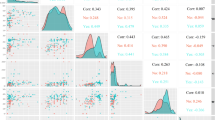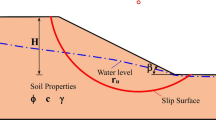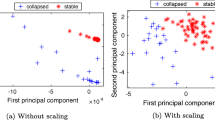Abstract
This paper presents DeepBoost based classification model for the slope stability problem, wherein an extensive dataset consisting of six features is used. The developed DeepBoost model is trained and tested with 444 stable and unstable slope cases. For comparison, the predictive performance of DeepBoost is systematically compared with the other state-of-the-art ML algorithms, i.e., Adaptive Boosting (AdaBoost.M1) and Support Vector Machine (SVM) based on the well-established confusion matrix, which contains the known metrics of Accuracy (Acc), Precision (P), Recall (R), F1-Score (F), and Kappa Score (κ). Furthermore, three hyperparameter optimization approaches, Grid Search (GS), Random Search (RS), and Bayesian Optimization (BO), have been integrated for tuning the hyperparameters of the DeepBoost and the other models to achieve the best results. Based on the comparative analysis, it was found that BO optimized DeepBoost model achieved the best performance score and accurately detected and classified all types of slope stability scenarios. Also, Bayesian optimized models performed better than GS and RS optimized ones. As a result, the comparison results of the developed DeepBoost model with the other models reveal that DeepBoost exhibited superior performance as compared to the other algorithms in the case of BO with an accuracy of Acc = 96.97% for DeepBoost, Acc = 95.45% for AdaBoostM1, and Acc = 90.91% for SVM.







Similar content being viewed by others
Data availability
The dataset analyzed during the current study are publicly available at location cited in the reference section.
References
Abramson LW, Lee TS, Sharma S, Boyce GM (2001) Slope stability and stabilization methods. Wiley
Azmoon B, Biniyaz A, Liu Z (2021) Evaluation of deep learning against conventional limit equilibrium methods for slope stability analysis. App Sci 11(13):6060. https://doi.org/10.3390/app11136060
Baker R (2003) A second look at Taylor’s stability chart. J Geotech Geoenviron Eng 129(12):1102–1108
Bergstra J, Bengio Y (2012) Random search for hyper-parameter optimization. J Mach Learn Res 13
Bharti JP, Mishra P, Moorthy U, Sathishkumar VE, Cho YY, Samui P (2021) Slope stability analysis using Rf, Gbm, Cart, Bt and Xgboost. Geotech Geol Eng 39:3741–3752. https://doi.org/10.1007/s10706-021-01721-2
Bishop AW (1955) The use of the slip circle in the stability analysis of slopes. Geotechnique 5:7–17
Boser BE, Guyon IM, Vapnik VN (1992) A training algorithm for optimal margin classifiers. In: Proceedings of the fifth annual workshop on Computational learning theory, pp 144–152
Brink H, Richards J, Fetherolf M (2016) Real-world machine learning. Simon and Schuster
Brochu E, Cora VM, De Freitas N (2010) A tutorial on Bayesian optimization of expensive cost functions, with application to active user modeling and hierarchical reinforcement learning. arXiv preprint http://arXiv.org/1012.2599
Cao DS, Xu QS, Liang YZ, Zhang LX, Li HD (2010) The boosting: a new idea of building models. Chemometr Intell Lab Sys 100:1–11. https://doi.org/10.1016/j.chemolab.2009.09.002
Chai J, Igaya Y, Hino T, Carter J (2013) Finite element simulation of an embankment on soft clay—case study. Comput Geotech 48:117–126
Chakraborty R, Dey A (2022) Probabilistic slope stability analysis: state-of-the-art review and future prospects. Innov Infrastruct Solut 7:1–19
Chen S, Ren J, Yan Y, Sun M, Hu F, Zhao H (2022) Multi-sourced sensing and support vector machine classification for effective detection of fire hazard in early stage. Comput Electr Eng 101:108046
Cheng MY, Hoang ND (2015) Typhoon-induced slope collapse assessment using a novel bee colony optimized support vector classifier. Nat Hazards 78:1961–1978. https://doi.org/10.1007/s11069-015-1813-8
Cortes C, Mohri M, Syed U (2014) Deep boosting. In: International conference on machine learning. PMLR, pp 1179–1187
Cortes C, Vapnik V (1995) Support-vector networks. Mach Learn 20:273–297
Demir S, Sahin EK (2022) Liquefaction prediction with robust machine learning algorithms (SVM, RF, and XGBoost) supported by genetic algorithm-based feature selection and parameter optimization from the perspective of data processing. Environ Earth Sci 81:1–17
Demir S, Sahin EK (2023) An investigation of feature selection methods for soil liquefaction prediction based on tree-based ensemble algorithms using AdaBoost, gradient boosting, and XGBoost. Neural Comput Appl. https://doi.org/10.1007/s00521-022-07856-44
Duncan JM (1996) Landslides: investigation and mitigation. Chapter 13-Soil slope stability analysis. Transportation Research Board Special Report
Eibl G, Pfeiffer KP (2002) How to make AdaBoost. M1 work for weak base classifiers by changing only one line of the code. In: European Conference on Machine Learning. Springer, pp 72–83
Fellenius W (1936) Calculation of stability of earth dam. In: Transactions 2nd Congress Large Dams, Washington, DC, pp 445–462
Freund Y, Schapire RE (1997) A decision-theoretic generalization of on-line learning and an application to boosting. J Comput Syst Sci 55:119–139
Griffiths D, Lane P (1999) Slope stability analysis by finite elements. Geotechnique 49:387–403
Habib M, Bashir B, Alsalman A, Bachir H (2023) Evaluating the accuracy and effectiveness of machine learning methods for rapidly determining the safety factor of road embankments. Multidiscip Model Mater Struct 19(5):966–983. https://doi.org/10.1108/MMMS-12-2022-0290
Hoang ND, Pham AD (2016) Hybrid artificial intelligence approach based on metaheuristic and machine learning for slope stability assessment: a multinational data analysis. Expert Syst Appl 46:60–68. https://doi.org/10.1016/j.eswa.2015.10.020
Hsu J-L, Hung P-C, Lin H-Y, Hsieh C-H (2015) Applying under-sampling techniques and cost-sensitive learning methods on risk assessment of breast cancer. J Med Syst 39:1–13
Huang YH (2014) Slope stability analysis by the limit equilibrium method: Fundamentals and methods. ASCE Publications, Reston
Jagielski J, Skawiński W (1978) The analysis and classification of chromosomes. I. Application of the Bayes’ theorem. Mater Med Pol 10:198–203
Janbu N (1973) Slope stability computations. Publication of: Wiley (John) and Sons, Incorporated
Javankhoshdel S, Bathurst RJ (2014) Simplified probabilistic slope stability design charts for cohesive and cohesive-frictional (c−ϕ) soils. Can Geotech J 51(9):1033–1045
Kardani N, Zhou AN, Nazem M, Shen SL (2021) Improved prediction of slope stability using a hybrid stacking ensemble method based on finite element analysis and field data. J Rock Mech Geotech 13:188–201. https://doi.org/10.1016/j.jrmge.2020.05.011
Karir D, Ray A, Bharati AK, Chaturvedi U, Rai R, Khandelwal M (2022) Stability prediction of a natural and man-made slope using various machine learning algorithms. Transp Geotech. https://doi.org/10.1016/j.trgeo.2022.100745
Kelesoglu M (2016) The evaluation of three-dimensional effects on slope stability by the strength reduction method. KSCE J Civ Eng 20:229–242
Keyport RN, Oommen T, Martha TR, Sajinkumar KS, Gierke JS (2018) A comparative analysis of pixel- and object-based detection of landslides from very high-resolution images. Int J Appl Earth Obs Geoinf 64:1–11. https://doi.org/10.1016/j.jag.2017.08.015
Kim D, Kwon K, Pham K, Oh JY, Choi H (2022) Surface settlement prediction for urban tunneling using machine learning algorithms with Bayesian optimization. Autom Constr. https://doi.org/10.1016/j.autcon.2022.104331
Li LC, Tang CA, Zhu WC, Liang ZZ (2009) Numerical analysis of slope stability based on the gravity increase method. Comput Geotech 36:1246–1258. https://doi.org/10.1016/j.compgeo.2009.06.004
Li AJ, Lim K, Fatty A (2020) Stability evaluations of three-layered soil slopes based on extreme learning neural network. J Chin Inst Eng 43(7):628–637
Lin Y, Zhou K, Li JL (2018) Prediction of slope stability using four supervised learning methods. Ieee Access 6:31169–31179. https://doi.org/10.1109/Access.2018.2843787
Lin S, Zheng H, Han B, Li Y, Han C, Li W (2022) Comparative performance of eight ensemble learning approaches for the development of models of slope stability prediction. Acta Geotech 17:1477–1502
Mahmoodzadeh A, Mohammadi M, Farid-Hama-Ali H, Hashim-Ibrahim H, Nariman-Abdulhamid S, Nejati HR (2022) Prediction of safety factors for slope stability: comparison of machine learning techniques. Nat Hazards 111:1771–1799
Michalowski RL (2002) Stability charts for uniform slopes. J Geotech Geoenviron Eng 128(4):351–355
Morgenstern NU, Price VE (1965) The analysis of the stability of general slip surfaces. Geotechnique 15:79–93
Pham K, Kim D, Park S, Choi H (2021) Ensemble learning-based classification models for slope stability analysis. CATENA. https://doi.org/10.1016/j.catena.2020.104886
Polikar R (2012) Ensemble learning. Ensemble machine learning. Springer, pp 1–34
Qi CC, Tang XL (2018) Slope stability prediction using integrated metaheuristic and machine learning approaches: a comparative study. Comput Ind Eng 118:112–122. https://doi.org/10.1016/j.cie.2018.02.028
Sahin EK (2023) Implementation of free and open-source semi-automatic feature engineering tool in landslide susceptibility mapping using the machine-learning algorithms RF, SVM, and XGBoost. Stoch Env Res Risk A. https://doi.org/10.1007/s00477-022-02330-y
Schapire RE (1990) The strength of weak learnability. Mach Learn 5:197–227
Singh P, Bardhan A, Han F, Samui P, Zhang W (2023) A critical review of conventional and soft computing methods for slope stability analysis. Model Earth Syst Environ 9(1):1–17. https://doi.org/10.1007/s40808-022-01489-1
Sjöberg J (2020) Analysis of the Aznalcollar pit slope failures—a case study. FLAC and numerical modeling in geomechanics. CRC Press, pp 63–70
Snoek J, Larochelle H, Adams RP (2012) Practical bayesian optimization of machine learning algorithms. Adv Neural Inform Process Syst 25
Song Y, Gong J, Gao S, Wang D, Cui T, Li Y, Wei B (2012) Susceptibility assessment of earthquake-induced landslides using Bayesian network: a case study in Beichuan, China. Comput Geosci 42:189–199
Song Q, Jin H, Hu X (2022) Automated machine learning in action. Manning Shelter Island
Steward T, Sivakugan N, Shukla SK, Das BM (2011) Taylor’s slope stability charts revisited. Int J Geomech 11(4):348–352
Suman S, Khan S, Das S, Chand S (2016) Slope stability analysis using artificial intelligence techniques. Nat Hazards 84:727–748
Taylor DW (1937) Stability of earth slopes. J Boston Soc Civ Eng 24(3):197–247
Tuv E (2006) Ensemble learning. In: Guyon I, Nikravesh M, Gunn S, Zadeh LA (eds) Feature extraction: foundations and applications. Springer Berlin Heidelberg, Berlin, Heidelberg, pp 187–204
Vapnik V (1999) The nature of statistical learning theory. Springer Science & Business Media, NY
Wang J, Wang Y (2016) Multi-period visual tracking via online deepboost learning. Neurocomputing 200:55–69
Wang L, Wu CZ, Tang LB, Zhang WG, Lacasse S, Liu HL, Gao L (2020) Efficient reliability analysis of earth dam slope stability using extreme gradient boosting method. Acta Geotech 15:3135–3150. https://doi.org/10.1007/s11440-020-00962-4
Wang N, Zhao SY, Cui SZ, Fan WG (2021) A hybrid ensemble learning method for the identification of gang-related arson cases. Knowl-Based Syst. https://doi.org/10.1016/j.knosys.2021.106875
Wang G, Zhao B, Wu B, Zhang C, Liu W (2022) Intelligent prediction of slope stability based on visual exploratory data analysis of 77 in situ cases. Int J Min Sci Tech 33:47–59
Wu J, Chen X-Y, Zhang H, Xiong L-D, Lei H, Deng S-H (2019) Hyperparameter optimization for machine learning models based on Bayesian optimization. J Electron Sci Tech 17:26–40
Xiao SG, Li SH (2022) LSSVM-based approach for refining soil failure criteria and calculating safety factor of slopes. Front Struct Civ Eng. https://doi.org/10.1007/s11709-022-0863-8
Zhang S, Lyu W, Yang F, Yan C, Zhou D, Zeng X, Hu X (2019) An efficient multi-fidelity bayesian optimization approach for analog circuit synthesis. In: 2019 56th ACM/IEEE Design Automation Conference (DAC). IEEE, pp 1–6
Zhang WG, Li HR, Han L, Chen LL, Wang L (2022) Slope stability prediction using ensemble learning techniques: a case study in Yunyang County, Chongqing, China. J Rock Mech Geotech Eng 14:1089–1099. https://doi.org/10.1016/j.jrmge.2021.12.011
Zhou J, Li EM, Yang S, Wang MZ, Shi XZ, Yao S, Mitri HS (2019) Slope stability prediction for circular mode failure using gradient boosting machine approach based on an updated database of case histories. Saf Sci 118:505–518. https://doi.org/10.1016/j.ssci.2019.05.046
Zhu D, Lee C (2002) Explicit limit equilibrium solution for slope stability. Int J Numer Anal Meth GeoMech 26:1573–1590
Funding
No funding was received for conducting this study.
Author information
Authors and Affiliations
Contributions
S.D. Conceptualization, Investigation, Writing-review and editing, Writing-original draft, Visualization. E.K.S. Conceptualization, Methodology, Software, Writing-review and editing, Visualization.
Corresponding author
Ethics declarations
Conflict of interest
The authors have no conflicts of interest to declare that are relevant to the content of this article.
Additional information
Publisher's Note
Springer Nature remains neutral with regard to jurisdictional claims in published maps and institutional affiliations.
Rights and permissions
Springer Nature or its licensor (e.g. a society or other partner) holds exclusive rights to this article under a publishing agreement with the author(s) or other rightsholder(s); author self-archiving of the accepted manuscript version of this article is solely governed by the terms of such publishing agreement and applicable law.
About this article
Cite this article
Demir, S., Sahin, E.K. Assessing the predictive capability of DeepBoost machine learning algorithm powered by hyperparameter tuning methods for slope stability prediction. Environ Earth Sci 82, 562 (2023). https://doi.org/10.1007/s12665-023-11247-w
Received:
Accepted:
Published:
DOI: https://doi.org/10.1007/s12665-023-11247-w




